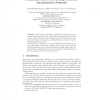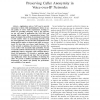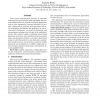16 search results - page 2 / 4 » P5: A Protocol for Scalable Anonymous Communication |
IJNSEC
2006
13 years 5 months ago
2006
Anonymity is a very important security feature in addition to authentication and key agreement features in communication protocols. In this paper, we propose two authentication an...
CCS
2009
ACM
14 years 5 days ago
2009
ACM
We introduce Torsk, a structured peer-to-peer low-latency anonymity protocol. Torsk is designed as an interoperable replacement for the relay selection and directory service of th...
SERSCISA
2009
Springer
13 years 12 months ago
2009
Springer
Node lookup mechanisms constitute an integral part of any overlay network, and hence also of anonymous communication networks. Today, most anonymizers use centralized directories, ...
SP
2008
IEEE
13 years 11 months ago
2008
IEEE
— Applications such as VoIP need to provide anonymity to clients while maintaining low latency to satisfy quality of service (QoS) requirements. Existing solutions for providing ...
ACSAC
2001
IEEE
13 years 9 months ago
2001
IEEE
Secure group communication protocols, in particular multi-party key agreement and update algorithms, help promote traditional and new Internet multi-party applications such as vid...



